Мегапост по оптическим иллюзиям (осторожно мозг!)
Careful! Don't hurt your brain looking at these. Better yet, warp your brain into another dimension.
It's easy to get dizzy just looking at these objects, trying to process how could they possibly be constructed and where is the mysterious "hidden joint, gap or break"? Today we are going to look at various shape, color, shadow and 3D perspective illusions:



(upper left image credit: Yui Kubo, middle image Francis Tabary)
1. Hard-to-Believe Colour Illusions
They will not make your dizzy, but they will make you doubt your eyes a few times. In some cases, the factual colors are so hard to believe, that you would need to bring them into Photoshop and actually measure the color values. Let's start with a well-known illusion, which still amazes me every time I look at it:
Believe it or not, square A and B are actually the same color! -

(image credit: Edward H. Adelson)
Here are more of messing-with-your-brain color examples:

(image credit: Rebas)
The "brown" tile on the floor and the "yellow" tile in the middle of the cube's side facing to the left ARE THE SAME COLOR! Hard to believe... here is another one.

(image via, by R. Beau Lotto)

(images via 1, 2)
The next one is rather less known, and also very weird: The Angry Face! - Click here to see this illusion...
2. Reflective Art & Mirror Illusions
These drawings seem to be (more or less) normal depictions of shipwrecks and storms, but if you put a cylindrical mirror on top of them, you'll see a Jules Verne portrait, or Walt Disney's face... (more of these here)


(images via)
Best examples of "reflective illusions" we've seen so far:

(original unknown)
3. Fake 3D Perspectives & Impossible 3D Sculptures
A classic example of topologically unique sculptures is the Moebius Strip. Emmanuel Lattes made probably the best representation of it in recent memory: 3D Printed Double Moebius Strip (more info) -
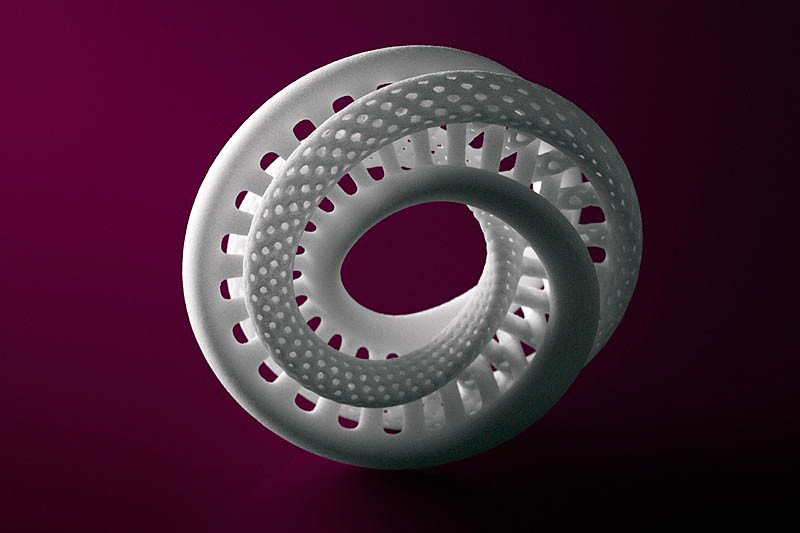
(image credit: Emmanuel Lattes)
Another artist who makes topologically confounding objects is Bulatov. See the whole gallery of his works made from steel and bronze (bottom row - made from wood):



(images credit: Bulatov)
As for the visually impossible 3D sculptures, well, they are not so much "impossible", in a sense that all these structures do exist. They're just "specially designed" to morph into geometrically impossible forms when seen at a particular viewing angle:


(images via)
French magician Francis Tabary created many such strange objects, some placed in an outdoor garden environment - all of them head-scratching and eye-catching examples of 3D optical illusions:
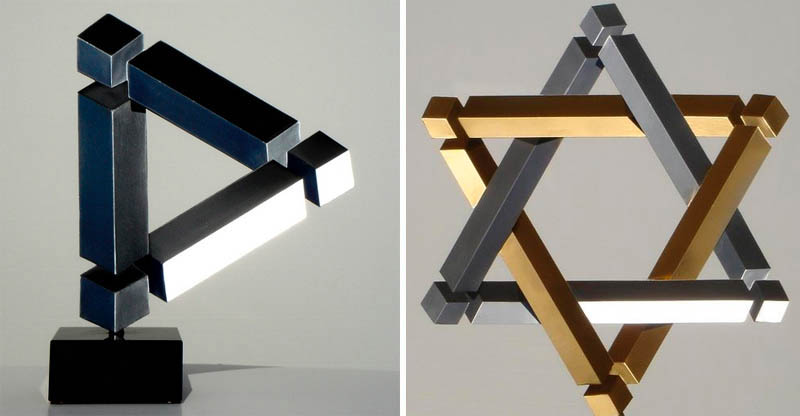


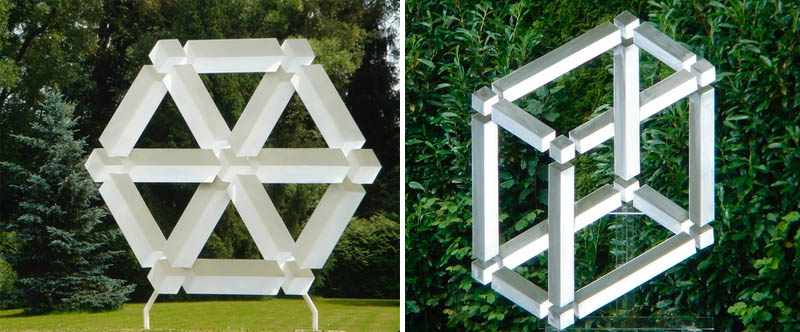
(images credit: Francis Tabary)
A doghouse? With some lost dogs inside -

(image via)
This image shows how this "impossible doghouse" was constructed. Just as you guessed, it's all about strategically placed gaps and a particular point of view:


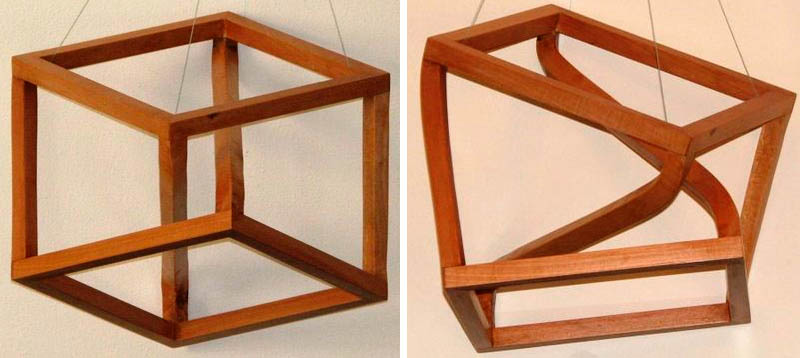
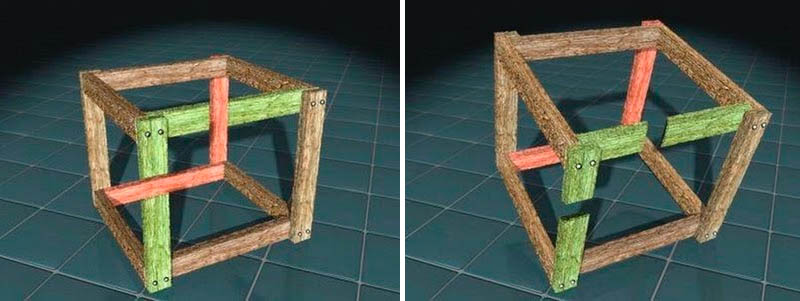
(originals unknown)
The "Impossible Dice" and the "Disappearing Column" by extremely inventive Japanese artist Shigeo Fukuda:

(images via)
His "Duet" sculpture transforms from a pianist to a violinist, when rotated or depending on your point of view:

(images by Shigeo Fukuda)
Computer-generated objects (even though they're just models) still hold a certain fascination and curiosity to the eye. Josh Sommers makes impossible objects look classy and even Art Deco-ish:



(images credit: Josh Sommers)
4. Shadow Illusions by Shigeo Fukuda
Shigeo Fukuda is famously known for creating a few completely mind-boggling Shadow Sculptures. The beautiful shadow shapes appear out of the complete chaos, out of the seemingly random piles of junk:

(images by Shigeo Fukuda)
This Shadow Illusion Text is by Francis Tabary:

(image credit: Francis Tabary)
Again, sublime reflections and shadows - to fit every mood:
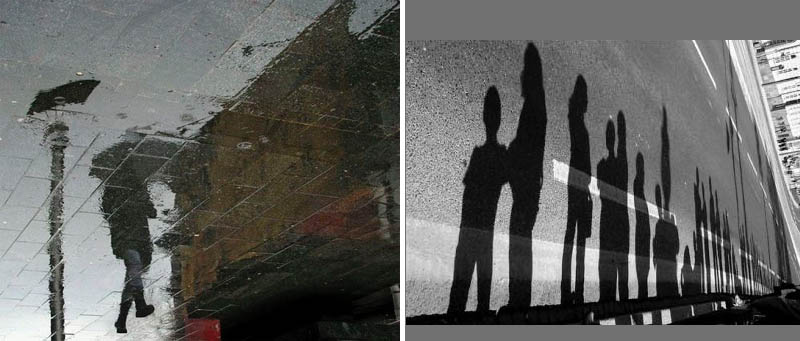
(originals unknown)
5. Impossible Architecture and Interior Design
"The Waterfall" falls firmly into the category of impossible sculptures, bringing to life the famous painting by M.C. Escher - see the original here. On the right is the same structure replicated in... LEGO (more info):


(images via 1, 2, 3, 4)
More mind-bending and surreal works by Escher:

(images via)
Another LEGO re-creation of M.C.Escher's stairs and labyrinthine rooms was made by Henry Lims:

(images credit: Henry Lims)
An impossible door (below right):

(images via)
6. Not what it seems! Masterpieces of 3D Street Pavement Art
Kurt Wenner is the foremost practitioner of this popular urban art subgenre. He paints epic, spiritual and inspiring 3D canvases on the humble street pavement, which fit perfectly in European cities, among Gothic cathedrals and gorgeous architecture:
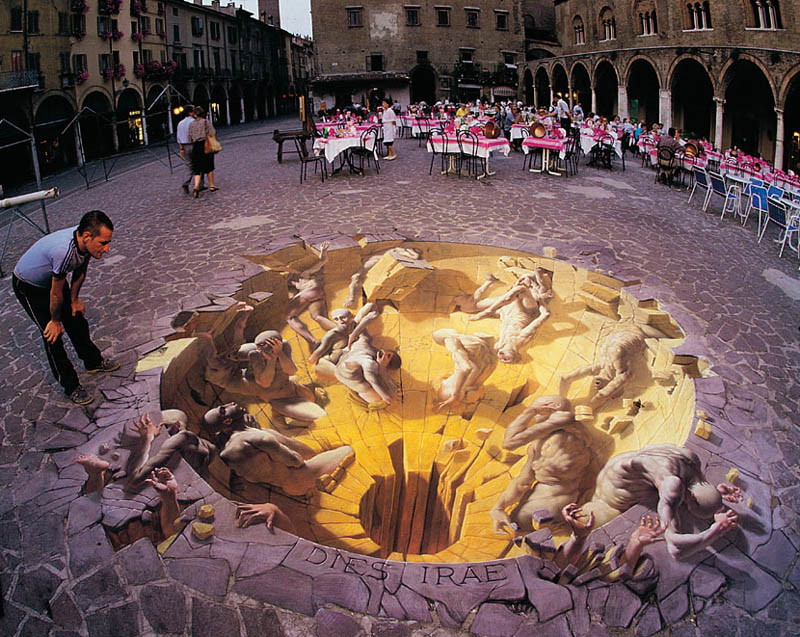
("Dies Irae (Day of Wrath)" - images credit: Kurt Wenner)
J. Beever has accumulated quite a portfolio of street paintings over the years. They are dizzying, strange, often humorous... Again, these so called "anamorphic illusions" create an impression of three dimensions only when seen at a particular angle:





(images credit: J. Beever)

(left: Edgar Mueller; right: J. Beever)
The "Crevasse" (above left) may have been inspired by the art of Julian Beever, but it is an independent and astonishing work by German artist Edgar Mueller - see more examples here.

(art by: Edgar Mueller, via)
Illusory Photo Manipulation in Advertising
Sometimes a particular advertising campaign can turn scary, surprising our senses with a "floor-less" elevator, see below. Of course, it's only a trick painting on the elevator's floor...

Imagine trying to pass a truck like this on a highway... giving more space to that sticking out bottle, just in case:

It's easy to see why the paintings below are so unique. Guido Daniele paints on hands... other advertising also uses feet:



And finally, these are not illusions, but photo-manipulated and mind-bending "reality" nevertheless:



Your eyes see one thing, your mind believes another!
Welcome our guest blogger Stefan Van den Bergh, who runs the "Planet Perplex" website. He writes: "I've been fascinated by illusions and everything like it for as long as I remember. Over the years I've made several sites about them, and built an extensive collection." It's been long since we had an article about optical illusions, so it's time for another installment in this highly popular series.

These don't move
Akiyoshi Kitaoka is a famous creator of moving illusions. That is, they seem to move but they don't.
Warning : these illusions are so strong that sensitive observers might feel sick. You will understand when you see them full-screen.
The first example is probably the most famous of them all and a favorite in poster stores: Rotating Snakes ! Make sure you click to enlarge.

When watching this picture, you might want to check if your flatscreen is still flat. Maybe it actually IS rippling.
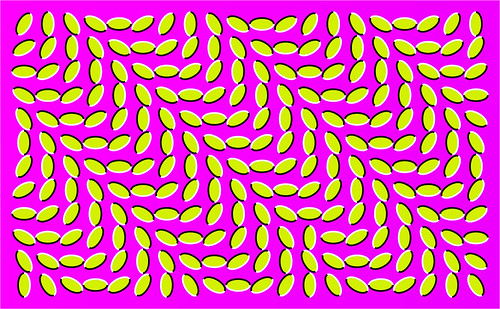
These rotating ladybugs are rather unknown but extremely convincing. You just can't believe this is not an animation. (Watch fullscreen, bigger is better.)
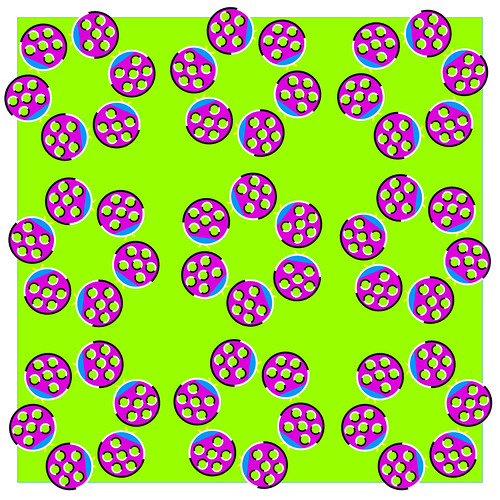
The last not-quite-moving one is also a classic but too good to leave it out. Stare at the black dot and move your head back and forth from the screen. The wheels will start turning ...

These do move - in strange ways
This little animation is fast becoming very popular - and no wonder: when you first look at the spinning girl, her rotation is probably clockwise. But if you start to concentrate on her shadow instead, suddenly her rotation switches to counter-clockwise! It may take some time, but the moment it happens, you are going to be genuinely surprised... (first seen here)

This ferris wheel animation is similar to the one above. Look at the left side of the wheel, and it will rotate to the left. Look at the right and it will rotate there. If you play around with it, you can make it turn wherever you want. Try it!
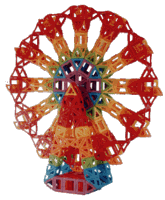
Unique Stereo Pictures can be created using a simple animation effect. This pool animation has only two frames, but looks convincingly three-dimensional.
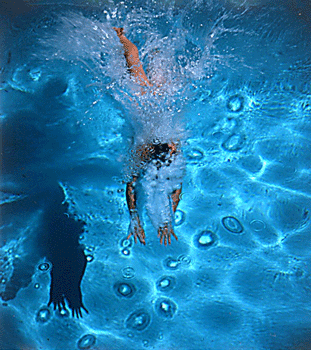
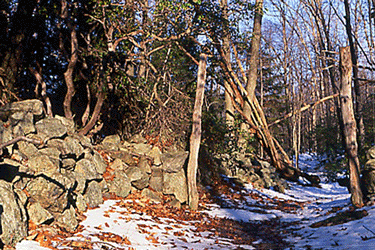

See more "stereo pictures" here.
Just a point of view
Have a look at this photograph of Neuchatel, Switzerland. How long would it have taken Felice Varini to put the red lines there ? Five minutes, with a pencil and a ruler ?
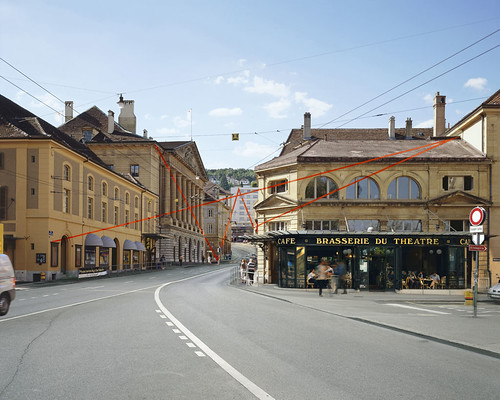
v
I don't know exactly but it would have been much, much longer. You see, the red lines are actually painted on the buildings. He just took buckets of red paint and got into town, as you will see below. This illusion only works from one exact point of view.

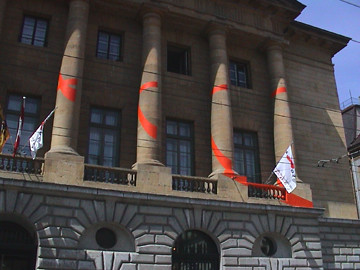
Here are some more examples of his work (there are dozens more at his site)
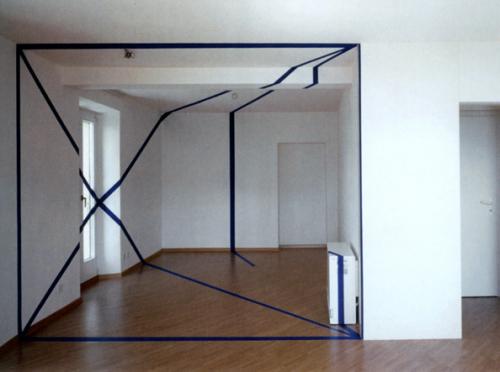
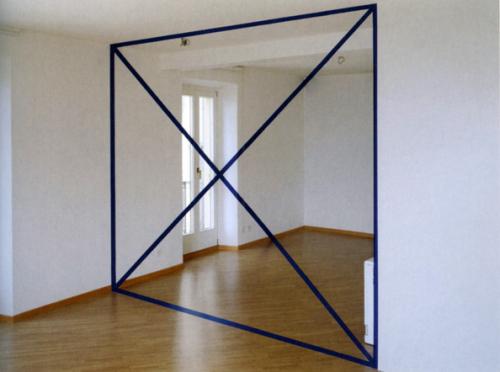


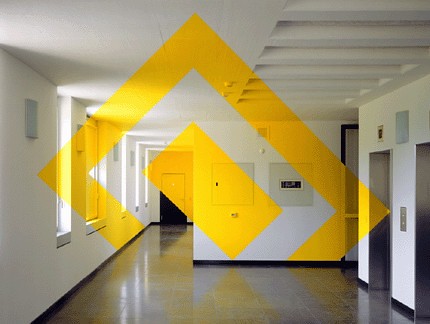
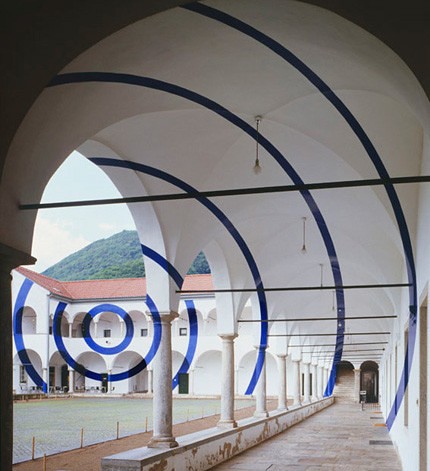

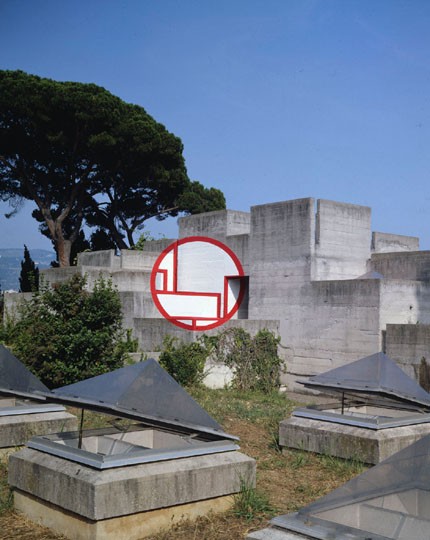
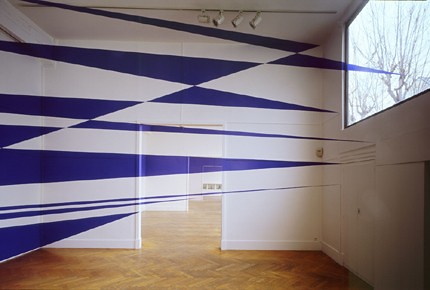
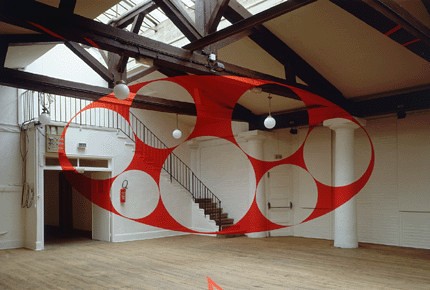

Another superb example of Varini's 3-D work is the Cardiff's Harbor, where the whole site became a "canvas" for Felice Varini's shapes, which could be discovered only from a specific viewpoint...
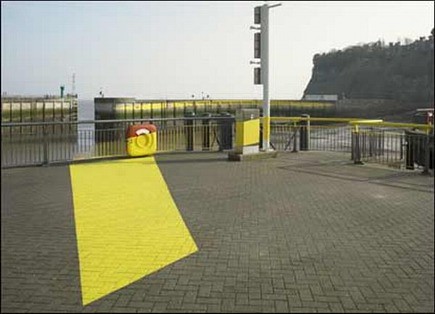
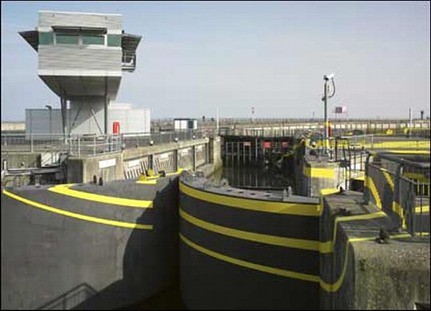
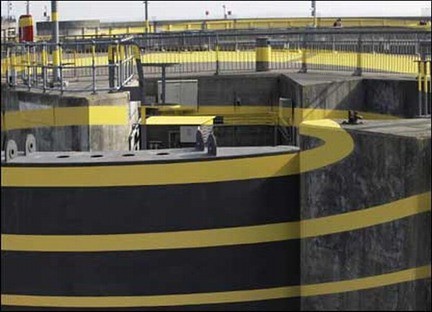
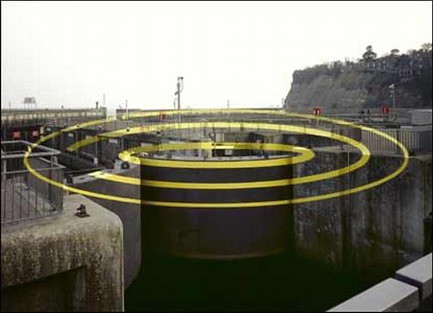
3-D Transformations
Shigeo Fukuda is another great point-of-view artist, "Master of Transformations". See for example his "Underground Piano". It looks like a large pile of junk, but when seen in a mirror just right, it's a perfect image of a piano.
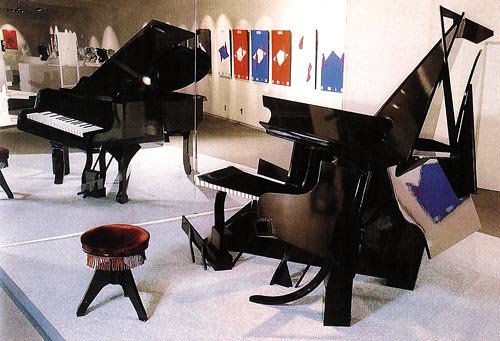
Here is "Encore" sculpture, which changes into different musicians, depending on your point-of-view. (via Growabrain)
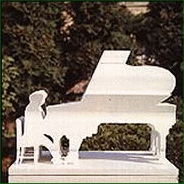
Shadow Sculptures
Again, by Shigeo Fukuda - watch this video to see the shadows transform a pile of junk.
Our illusions coverage will be incomplete if we don't mention other "shadow sculptures" - see a superb page here

But point-of-view illusions can also happen just by accident. And when they do, the result can be hilarious ...






(image credit: sepultura)
For an interesting case of "cover-up" viewing-angle illusion (and a study of Medieval morals) see this page
Now you see it ...
Now a bit of magic - let's make some stuff disappear. The first illusion is a classic, but keeps baffling me every time. Stare at the black cross in the center. Within seconds, a green ball will appear. And a few seconds after that, the green ball starts eating the purple balls, until there's nothing left !

This one has no moving parts. Just look at the black cross and see the colored fluff fade away until everything is gray. See how easy your eyes are fooled ?
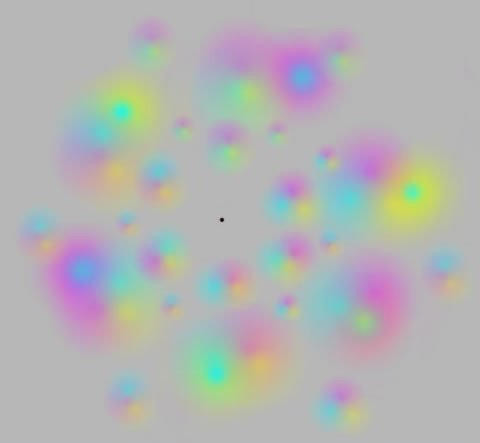
Speaking about elusive color... This link is simply mind-boggling. Follow the instructions to see the color appear out of black-n-white image of the castle. Click here
Adding to more well known images (see our first part), here is a variation of "shading illusion" - these two cubes are the SAME color!
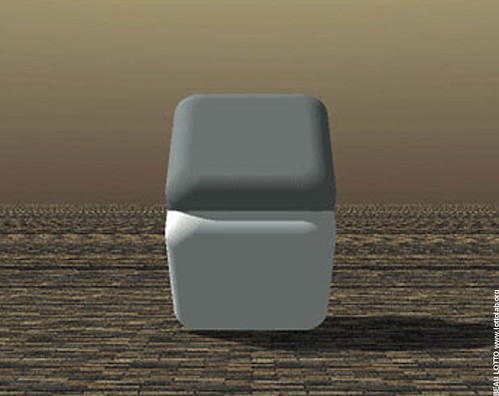
Illusions in Advertising
Discover darker meaning in this fine example of "hidden image" advertising:

For those with a lot of time on their hands, here is a great image from Mighty Optical Illusions - try to find all 82 Absolut vodka bottles in this drawing:
(click to enlarge)

(image credit: Mighty Optical Illusions, and Edith Wentz)
San Francisco Red Cross awareness ad campaign is slightly shocking, depicting the same street-scape after some kind of cataclysm: (seen here)
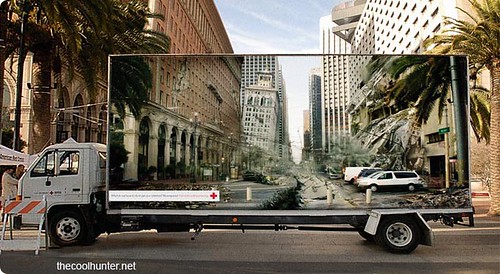

A bit nicer locations are shown on the following Club Med ads - with a cute face in each one.






Sometimes there is no need to "enhance" Mother Nature with a Photoshop job: check out this "portrait" of the actual rainforest insect:
(courtesy Darlyne Murawski)
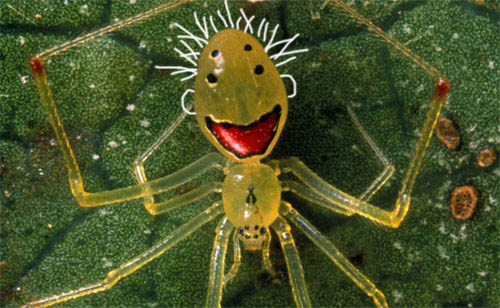
Article by Stefan Van den Bergh, "Planet Perplex" (with Avi Abrams) for Dark Roasted Blend. - (want to join our team of writers? contact us, see guidelines here)
We love it when the picture plays with our mind
To achieve different angle, illusion or an unusual effect with only two-dimensional picture is a challenge many photographers and artists can't seem to pass by. The three-dimensional sculptures can increase the "I simply can not believe this is real" effect. But in every occasion we keep asking ourselves how the trick was pulled off, and such mind-games appear to be a part of the magic.

"The House, that Swift Built"
(image credit: Anna Gunter)

(image credit: Josh Sommers)

(image credit: Josh Sommers)

(images credit: Istvan Orosz)
But did you know that some illusions can actually be constructed in real life?

(image credit: Shigeo Fukuda.html)
Aldo Cavini Benedetti made the working model of M. C. Escher's "Ascending and Descending" using a toy "Geomag" constructor set:

(image credit: Aldo Cavini Benedetti)
The video is almost out-of-this-world:
The "Impossible Triangle" is also possible to make, see the instructions here - with a printable template from that site, anybody can make it!

(image credit: Scott Henderson)
Almost real:

(image credit: Simon Scott)
Illusions in Art
One certain way to prompt the viewer to look twice in the picture is to create a "topsy-turvy" images, meaningful in both orientations.


Transformations! -

(image credit: Sandro del Prete)
Hidden figures:
A new meaning for "suggestive" painting -

(image credit: Sandro del Prete)

(image credit: Sandro del Prete)
This "Tree of Faces" is a classic:

Animal "matryoshka":

Mona Lisa:

This is a screenshot from the movie "Alexander". An interesting effect, but perhaps not that many people notice:

The following images are without credits, so please help us to locate the originals:



(image credit: Jonathon Bowser)


(image credit: Octavio Ocampo)
Impossible geometry
These artists can not revise the foundations of perspective and geometry, but they certainly fool the eye of a viewer:

(art by Dirk Huizer)

(image credit: Sandro del Prete)

(image credit: Sandro del Prete)

(image credit: Hermann Paulsen)

(art by Zenon Kulpa)

(image credit: Natalia Ivanova)
"The Magic Window" by Istvan Orosz

(image credit: Istvan Orosz)
Paintings by Flemish artist Jos de Mey continue in the "old Belgian masters" traditional style, only they clearly show impossible landscapes:





(images credit: Jos de Mey)
Other "impossible art" painters:

(image credit: Irvine Peacock)

(image credit: Irvine Peacock)

(image credit: Walter Wick)
Great "recursion" effect:

(image credit: Norman Parker)
Original creator of "impossible triangles" (1934) - Oscar Reutersvärd, Sweden.
Wrap your mind around this geometry:



(images credit: Oscar Reutersvärd)
Dmitry Rakov went even further, creating "impossible alphabet":

and "impossible labyrinth":

See another incredible figures alphabet on this page.
Here is one interesting puzzle:

(image credit: Gianni Sarconi)
If your kid has some trouble assembling the toy, maybe he's got instructions like this:

(image credit: Govert Shilling)
Snakes on a... thing:

(art by Peter Raedschelders)
Sometimes the confusing effect is all-too-easily achieved:


You can use money bills, or magazines:
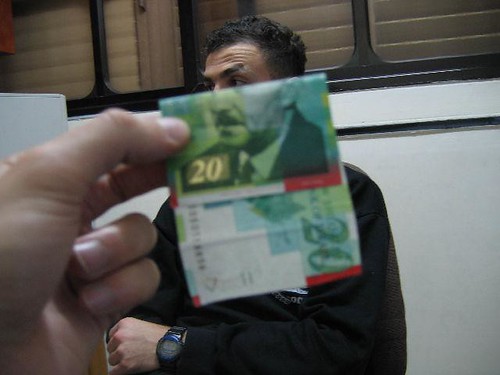

(image credit: Meg Picard)
See more of this interesting effect here
Illusions in Advertising:


Not an optical illusion, but a good test of your "attention to detail":
How many "F"s are in this sentence?
FINISHED FILES ARE THE RE-
SULT OF YEARS OF SCIENTIF-
IC STUDY COMBINED WITH THE
EXPERIENCE OF MANY YEARS
Scroll down for answer... in the meantime, see if you can spot anything wrong with this image:

(image credit: planetperplex)
ANSWER:
There are six F's in the sentence. There is no catch. Many people forget the F in "OF", and that word appears three times in the sentence. The human brain tends to see them as V's and not F's! If you spotted four, five, or even all six, well you beat the average!
Life imitates illusion
Do you remember M. C. Escher's "impossible staircases"?

well, somebody found the similar structure somewhere in Russia:

Источник
It's easy to get dizzy just looking at these objects, trying to process how could they possibly be constructed and where is the mysterious "hidden joint, gap or break"? Today we are going to look at various shape, color, shadow and 3D perspective illusions:



(upper left image credit: Yui Kubo, middle image Francis Tabary)
1. Hard-to-Believe Colour Illusions
They will not make your dizzy, but they will make you doubt your eyes a few times. In some cases, the factual colors are so hard to believe, that you would need to bring them into Photoshop and actually measure the color values. Let's start with a well-known illusion, which still amazes me every time I look at it:
Believe it or not, square A and B are actually the same color! -

(image credit: Edward H. Adelson)
Here are more of messing-with-your-brain color examples:

(image credit: Rebas)
The "brown" tile on the floor and the "yellow" tile in the middle of the cube's side facing to the left ARE THE SAME COLOR! Hard to believe... here is another one.

(image via, by R. Beau Lotto)

(images via 1, 2)
The next one is rather less known, and also very weird: The Angry Face! - Click here to see this illusion...
2. Reflective Art & Mirror Illusions
These drawings seem to be (more or less) normal depictions of shipwrecks and storms, but if you put a cylindrical mirror on top of them, you'll see a Jules Verne portrait, or Walt Disney's face... (more of these here)


(images via)
Best examples of "reflective illusions" we've seen so far:

(original unknown)
3. Fake 3D Perspectives & Impossible 3D Sculptures
A classic example of topologically unique sculptures is the Moebius Strip. Emmanuel Lattes made probably the best representation of it in recent memory: 3D Printed Double Moebius Strip (more info) -

(image credit: Emmanuel Lattes)
Another artist who makes topologically confounding objects is Bulatov. See the whole gallery of his works made from steel and bronze (bottom row - made from wood):



(images credit: Bulatov)
As for the visually impossible 3D sculptures, well, they are not so much "impossible", in a sense that all these structures do exist. They're just "specially designed" to morph into geometrically impossible forms when seen at a particular viewing angle:


(images via)
French magician Francis Tabary created many such strange objects, some placed in an outdoor garden environment - all of them head-scratching and eye-catching examples of 3D optical illusions:




(images credit: Francis Tabary)
A doghouse? With some lost dogs inside -

(image via)
This image shows how this "impossible doghouse" was constructed. Just as you guessed, it's all about strategically placed gaps and a particular point of view:




(originals unknown)
The "Impossible Dice" and the "Disappearing Column" by extremely inventive Japanese artist Shigeo Fukuda:

(images via)
His "Duet" sculpture transforms from a pianist to a violinist, when rotated or depending on your point of view:

(images by Shigeo Fukuda)
Computer-generated objects (even though they're just models) still hold a certain fascination and curiosity to the eye. Josh Sommers makes impossible objects look classy and even Art Deco-ish:



(images credit: Josh Sommers)
4. Shadow Illusions by Shigeo Fukuda
Shigeo Fukuda is famously known for creating a few completely mind-boggling Shadow Sculptures. The beautiful shadow shapes appear out of the complete chaos, out of the seemingly random piles of junk:

(images by Shigeo Fukuda)
This Shadow Illusion Text is by Francis Tabary:

(image credit: Francis Tabary)
Again, sublime reflections and shadows - to fit every mood:

(originals unknown)
5. Impossible Architecture and Interior Design
"The Waterfall" falls firmly into the category of impossible sculptures, bringing to life the famous painting by M.C. Escher - see the original here. On the right is the same structure replicated in... LEGO (more info):


(images via 1, 2, 3, 4)
More mind-bending and surreal works by Escher:

(images via)
Another LEGO re-creation of M.C.Escher's stairs and labyrinthine rooms was made by Henry Lims:

(images credit: Henry Lims)
An impossible door (below right):

(images via)
6. Not what it seems! Masterpieces of 3D Street Pavement Art
Kurt Wenner is the foremost practitioner of this popular urban art subgenre. He paints epic, spiritual and inspiring 3D canvases on the humble street pavement, which fit perfectly in European cities, among Gothic cathedrals and gorgeous architecture:

("Dies Irae (Day of Wrath)" - images credit: Kurt Wenner)
J. Beever has accumulated quite a portfolio of street paintings over the years. They are dizzying, strange, often humorous... Again, these so called "anamorphic illusions" create an impression of three dimensions only when seen at a particular angle:





(images credit: J. Beever)

(left: Edgar Mueller; right: J. Beever)
The "Crevasse" (above left) may have been inspired by the art of Julian Beever, but it is an independent and astonishing work by German artist Edgar Mueller - see more examples here.

(art by: Edgar Mueller, via)
Illusory Photo Manipulation in Advertising
Sometimes a particular advertising campaign can turn scary, surprising our senses with a "floor-less" elevator, see below. Of course, it's only a trick painting on the elevator's floor...

Imagine trying to pass a truck like this on a highway... giving more space to that sticking out bottle, just in case:

It's easy to see why the paintings below are so unique. Guido Daniele paints on hands... other advertising also uses feet:



And finally, these are not illusions, but photo-manipulated and mind-bending "reality" nevertheless:



Your eyes see one thing, your mind believes another!
Welcome our guest blogger Stefan Van den Bergh, who runs the "Planet Perplex" website. He writes: "I've been fascinated by illusions and everything like it for as long as I remember. Over the years I've made several sites about them, and built an extensive collection." It's been long since we had an article about optical illusions, so it's time for another installment in this highly popular series.

These don't move
Akiyoshi Kitaoka is a famous creator of moving illusions. That is, they seem to move but they don't.
Warning : these illusions are so strong that sensitive observers might feel sick. You will understand when you see them full-screen.
The first example is probably the most famous of them all and a favorite in poster stores: Rotating Snakes ! Make sure you click to enlarge.

When watching this picture, you might want to check if your flatscreen is still flat. Maybe it actually IS rippling.

These rotating ladybugs are rather unknown but extremely convincing. You just can't believe this is not an animation. (Watch fullscreen, bigger is better.)

The last not-quite-moving one is also a classic but too good to leave it out. Stare at the black dot and move your head back and forth from the screen. The wheels will start turning ...

These do move - in strange ways
This little animation is fast becoming very popular - and no wonder: when you first look at the spinning girl, her rotation is probably clockwise. But if you start to concentrate on her shadow instead, suddenly her rotation switches to counter-clockwise! It may take some time, but the moment it happens, you are going to be genuinely surprised... (first seen here)

This ferris wheel animation is similar to the one above. Look at the left side of the wheel, and it will rotate to the left. Look at the right and it will rotate there. If you play around with it, you can make it turn wherever you want. Try it!

Unique Stereo Pictures can be created using a simple animation effect. This pool animation has only two frames, but looks convincingly three-dimensional.



See more "stereo pictures" here.
Just a point of view
Have a look at this photograph of Neuchatel, Switzerland. How long would it have taken Felice Varini to put the red lines there ? Five minutes, with a pencil and a ruler ?

v
I don't know exactly but it would have been much, much longer. You see, the red lines are actually painted on the buildings. He just took buckets of red paint and got into town, as you will see below. This illusion only works from one exact point of view.


Here are some more examples of his work (there are dozens more at his site)











Another superb example of Varini's 3-D work is the Cardiff's Harbor, where the whole site became a "canvas" for Felice Varini's shapes, which could be discovered only from a specific viewpoint...




3-D Transformations
Shigeo Fukuda is another great point-of-view artist, "Master of Transformations". See for example his "Underground Piano". It looks like a large pile of junk, but when seen in a mirror just right, it's a perfect image of a piano.

Here is "Encore" sculpture, which changes into different musicians, depending on your point-of-view. (via Growabrain)

Shadow Sculptures
Again, by Shigeo Fukuda - watch this video to see the shadows transform a pile of junk.
Our illusions coverage will be incomplete if we don't mention other "shadow sculptures" - see a superb page here

But point-of-view illusions can also happen just by accident. And when they do, the result can be hilarious ...






(image credit: sepultura)
For an interesting case of "cover-up" viewing-angle illusion (and a study of Medieval morals) see this page
Now you see it ...
Now a bit of magic - let's make some stuff disappear. The first illusion is a classic, but keeps baffling me every time. Stare at the black cross in the center. Within seconds, a green ball will appear. And a few seconds after that, the green ball starts eating the purple balls, until there's nothing left !

This one has no moving parts. Just look at the black cross and see the colored fluff fade away until everything is gray. See how easy your eyes are fooled ?

Speaking about elusive color... This link is simply mind-boggling. Follow the instructions to see the color appear out of black-n-white image of the castle. Click here
Adding to more well known images (see our first part), here is a variation of "shading illusion" - these two cubes are the SAME color!

Illusions in Advertising
Discover darker meaning in this fine example of "hidden image" advertising:

For those with a lot of time on their hands, here is a great image from Mighty Optical Illusions - try to find all 82 Absolut vodka bottles in this drawing:
(click to enlarge)

(image credit: Mighty Optical Illusions, and Edith Wentz)
San Francisco Red Cross awareness ad campaign is slightly shocking, depicting the same street-scape after some kind of cataclysm: (seen here)


A bit nicer locations are shown on the following Club Med ads - with a cute face in each one.






Sometimes there is no need to "enhance" Mother Nature with a Photoshop job: check out this "portrait" of the actual rainforest insect:
(courtesy Darlyne Murawski)

Article by Stefan Van den Bergh, "Planet Perplex" (with Avi Abrams) for Dark Roasted Blend. - (want to join our team of writers? contact us, see guidelines here)
We love it when the picture plays with our mind
To achieve different angle, illusion or an unusual effect with only two-dimensional picture is a challenge many photographers and artists can't seem to pass by. The three-dimensional sculptures can increase the "I simply can not believe this is real" effect. But in every occasion we keep asking ourselves how the trick was pulled off, and such mind-games appear to be a part of the magic.

"The House, that Swift Built"
(image credit: Anna Gunter)

(image credit: Josh Sommers)

(image credit: Josh Sommers)

(images credit: Istvan Orosz)
But did you know that some illusions can actually be constructed in real life?

(image credit: Shigeo Fukuda.html)
Aldo Cavini Benedetti made the working model of M. C. Escher's "Ascending and Descending" using a toy "Geomag" constructor set:

(image credit: Aldo Cavini Benedetti)
The video is almost out-of-this-world:
The "Impossible Triangle" is also possible to make, see the instructions here - with a printable template from that site, anybody can make it!

(image credit: Scott Henderson)
Almost real:

(image credit: Simon Scott)
Illusions in Art
One certain way to prompt the viewer to look twice in the picture is to create a "topsy-turvy" images, meaningful in both orientations.


Transformations! -

(image credit: Sandro del Prete)
Hidden figures:
A new meaning for "suggestive" painting -

(image credit: Sandro del Prete)

(image credit: Sandro del Prete)
This "Tree of Faces" is a classic:

Animal "matryoshka":

Mona Lisa:

This is a screenshot from the movie "Alexander". An interesting effect, but perhaps not that many people notice:

The following images are without credits, so please help us to locate the originals:



(image credit: Jonathon Bowser)


(image credit: Octavio Ocampo)
Impossible geometry
These artists can not revise the foundations of perspective and geometry, but they certainly fool the eye of a viewer:

(art by Dirk Huizer)

(image credit: Sandro del Prete)

(image credit: Sandro del Prete)

(image credit: Hermann Paulsen)

(art by Zenon Kulpa)

(image credit: Natalia Ivanova)
"The Magic Window" by Istvan Orosz

(image credit: Istvan Orosz)
Paintings by Flemish artist Jos de Mey continue in the "old Belgian masters" traditional style, only they clearly show impossible landscapes:





(images credit: Jos de Mey)
Other "impossible art" painters:

(image credit: Irvine Peacock)

(image credit: Irvine Peacock)

(image credit: Walter Wick)
Great "recursion" effect:

(image credit: Norman Parker)
Original creator of "impossible triangles" (1934) - Oscar Reutersvärd, Sweden.
Wrap your mind around this geometry:



(images credit: Oscar Reutersvärd)
Dmitry Rakov went even further, creating "impossible alphabet":

and "impossible labyrinth":

See another incredible figures alphabet on this page.
Here is one interesting puzzle:

(image credit: Gianni Sarconi)
If your kid has some trouble assembling the toy, maybe he's got instructions like this:

(image credit: Govert Shilling)
Snakes on a... thing:

(art by Peter Raedschelders)
Sometimes the confusing effect is all-too-easily achieved:


You can use money bills, or magazines:


(image credit: Meg Picard)
See more of this interesting effect here
Illusions in Advertising:


Not an optical illusion, but a good test of your "attention to detail":
How many "F"s are in this sentence?
FINISHED FILES ARE THE RE-
SULT OF YEARS OF SCIENTIF-
IC STUDY COMBINED WITH THE
EXPERIENCE OF MANY YEARS
Scroll down for answer... in the meantime, see if you can spot anything wrong with this image:

(image credit: planetperplex)
ANSWER:
There are six F's in the sentence. There is no catch. Many people forget the F in "OF", and that word appears three times in the sentence. The human brain tends to see them as V's and not F's! If you spotted four, five, or even all six, well you beat the average!
Life imitates illusion
Do you remember M. C. Escher's "impossible staircases"?

well, somebody found the similar structure somewhere in Russia:

Источник